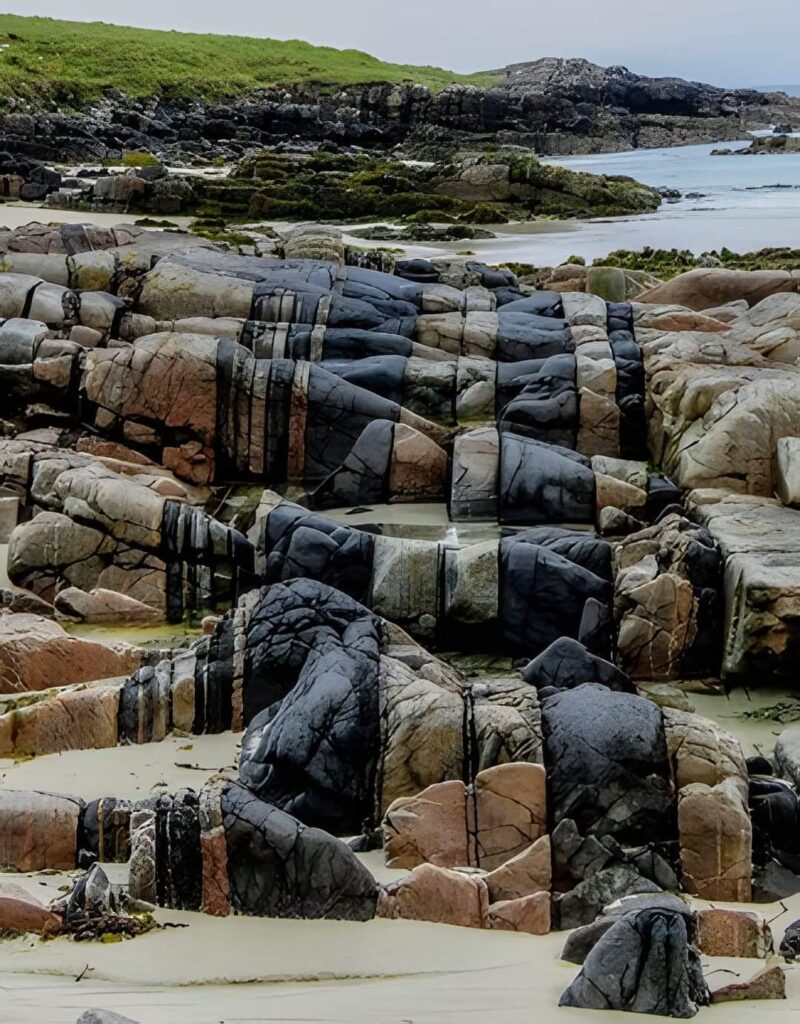Introduction: Where Nature Paints in Layers
Scotland’s rugged coastlines are famous for their raw, untamed beauty, but tucked away on the island of North Uist lies something far more extraordinary. The Banded Rocks of Hosta Beach are not only a breathtaking spectacle but a geologist’s dream come true. These unique formations, found in the Outer Hebrides, are some of the oldest rocks in Europe, offering us a rare glimpse into Earth’s deep history. While Scotland boasts many natural rock formations, the banded rocks at Hosta Beach stand apart with their striking patterns and rare geological complexity. They reveal the dynamic history of the Earth’s crust, from tectonic movements to metamorphic processes, all laid bare in visually compelling strata.
As we explore the Banded Rocks of Hosta Beach, we’ll look into their geological significance, petrological characteristics, and the cultural context that makes this place not just a site of scientific interest but a natural wonder worthy of global attention.
Read also: Types of Rocks: 3 Processes that Shatter and Transform
Where Is Hosta Beach Located?
Hosta Beach lies on the northwest coast of North Uist, one of the main islands in Scotland’s Outer Hebrides archipelago. Known for its windswept dunes, pristine sands, and turquoise waters, the beach itself is a hidden treasure. But it’s the Banded Rocks of Hosta Beach that steal the show.

Quick Location Facts:
| Feature | Description |
|---|---|
| Island | North Uist |
| Region | Outer Hebrides, Scotland |
| Coordinates | 57.6515° N, 7.4901° W |
| Access | Car + short walk from B894 road |
The area is remote but accessible. From the mainland, visitors often take a ferry to Lochmaddy and drive across the island. The road signs are clear, and the local community maintains the area with a great sense of pride.
Read also: Discover Floating Island: A Unique Natural Wonder
How Were the Banded Rocks Formed?
The Science Behind the Stripes
The Banded Rocks of Hosta Beach are primarily composed of ancient Lewisian Gneiss, which dates back over 3 billion years. These metamorphic rocks have undergone intense heat and pressure over millennia, resulting in the distinct banding patterns we see today.
Geological Timeline
- Archean Eon (3.0+ billion years ago): Formation of original gneissic rock.
- Proterozoic Eon (2.5 billion years ago): Additional metamorphic episodes.
- Caledonian Orogeny (400 million years ago): Tectonic uplift and exposure.
Read also: Facts About Metamorphic Rocks: 5 Shocking Secrets of Rocks Under Pressure

Why the Banding?
The banded appearance results from:
- Foliation: Alignment of minerals due to pressure.
- Metasomatism: Chemical alteration of rock during metamorphism.
- Layering: Alternation of quartz-rich and feldspar-rich bands.
These rock layers appear almost painted, with rhythmic light and dark stripes that evoke movement frozen in time. The phenomenon is closely linked to banded rocks geology, a subfield of structural geology that examines mineral alignments and folding patterns.
Read also: Physical Weathering: The Mechanical Breakdown of Rocks
A Journey Through Time: The Story These Rocks Tell
Read also:
Geologists believe the Banded Rocks of Hosta Beach were formed during the Archean Eon, more than 3 billion years ago, when the earliest segments of the Earth’s crust began to stabilize. These rocks belong to the Lewisian Gneiss Complex, one of the most ancient geological units in the world, and offer rare, direct evidence of Earth’s primordial conditions. The Banded Rocks of Hosta Beach have endured billions of years of tectonic activity, including episodes of subduction, continental collision, uplift, and relentless erosion. These dynamic processes sculpted the layered appearance visible today, representing a vivid archive of Earth’s internal and surface evolution.
Read also: Our Dynamic Planet: How Plate Tectonics Shapes the World
“These rocks offer a direct window into Earth’s Archean past, a period not well represented in exposed rocks globally.” — Dr. David Brown, University of Edinburgh
From a banded rock geology perspective, the contrasting bands of light and dark minerals—primarily quartz, feldspar, and mica—signify different metamorphic events and mineral realignments. The bands act like geological fingerprints, helping scientists reconstruct the environmental conditions of deep time.

While the scientific community values the Banded Rocks of Hosta Beach for their contribution to understanding natural rock formations in Scotland, local Hebridean communities also attach cultural significance to them. According to oral tradition, these rocks were not just shaped by Earth’s forces but by mythical beings. One enduring legend tells that the banded patterns were etched by ancient giants who roamed the islands long before humans. These folkloric stories, though mythical, reflect the reverence and mystery the islanders associate with the land.
In this blend of science and story, the Banded Rocks of Hosta Beach embody more than just geological wonders in Scotland—they serve as bridges between Earth’s deep past and human imagination. This union of fact and folklore adds layers of meaning to the rocks, making them not only objects of academic study but also symbols of cultural heritage and natural resilience giants. Though mythical, these tales reflect the reverence locals hold for the site.
Read also: 10 Rare Celestial Omens That Sparked Awe and Fear Across Cultures
Best Time to Visit Hosta Beach and Capture the Banded Rocks
Ideal Conditions for Photography:
- Golden Hours: Sunrise and sunset offer the best lighting.
- Tide Awareness: Low tide reveals the full extent of rock formations.
- Season: Late spring to early autumn is best for weather and light conditions.
What to Bring:
- Wide-angle lens for capturing rock layers.
- Neutral density filters for long exposure shots.
- Hiking boots and a windproof jacket.
Don’t forget to respect the site—it’s not only a natural landmark but a fragile geological archive.
Read also: 6 Great Monolithic Rocks of the World: Majestic Wonders of Nature
What Else to Explore Around Hosta Beach
Hosta Beach isn’t just about geology. It’s surrounded by rich biodiversity and cultural points of interest.
Local Attractions:
- Balranald Nature Reserve: Home to rare bird species and machair landscapes.
- Taigh Chearsabhagh Museum: Exhibits on Hebridean culture and geology.
- Langass Stone Circle: Prehistoric stone monument nearby.

These nearby sites add cultural and ecological depth to your visit, making it ideal for extended exploration.
Read also: 10 Landmarks That Should Be Considered Wonders of the World
Preserving the Beauty: Respecting the Land and Rocks
The Banded Rocks of Hosta Beach are part of a fragile environment. The local government and conservation groups encourage responsible tourism.
Key Practices:
- Leave No Trace.
- Do not collect rocks or disturb formations.
- Stay on marked paths.
- Support local conservation initiatives.
Read also: Catatumbo Lightning: 8 Incredible Facts about the Mystery of Maracaibo Lake
Final Thoughts: Why You Should Visit Hosta Beach’s Banded Rocks
The Banded Rocks of Hosta Beach aren’t just another scenic attraction in Scotland. They are tangible records of Earth’s primordial past. Standing on that stretch of shoreline, one realizes how much history is embedded within each stripe of gneiss. This site invites us to think on geological timescales, to marvel at forces that shaped continents, and to appreciate the subtle but powerful artistry of nature.
In an age dominated by digital images and fleeting experiences, a visit to Hosta Beach offers something far more lasting—a connection to the story of Earth itself. From its geological depth to its natural beauty, this site is a must-see for travelers, photographers, and science enthusiasts alike.
So next time you’re exploring geological wonders in Scotland, don’t overlook this remote but rewarding destination. The banded rocks await.
FAQs
1. What type of rock is found at Hosta Beach?
The rocks are primarily Lewisian Gneiss, a metamorphic rock over 3 billion years old.
2. Is Hosta Beach safe for tourists?
Yes, but visitors should check tide schedules and wear appropriate gear.
3. Can I collect rock samples from the beach?
No, rock collection is discouraged to preserve the site.
4. What is the best season to visit Hosta Beach?
Late spring to early autumn offers the best weather and visibility.
5. How do I reach Hosta Beach?
Drive from Lochmaddy, then follow local signage to the beach.
6. Are there guided tours available?
Occasionally, local naturalists offer seasonal guided walks.

